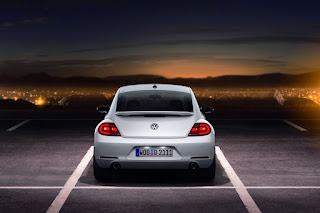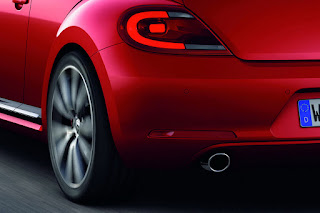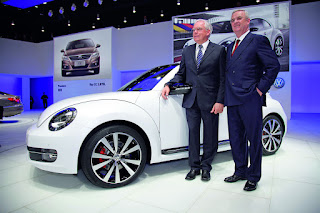The newest interpretation of the Bug comes 73 years after the launch of the original Beetle in 1938, which sold an amazing 21.5 million units, and 13 years after the debut of the New Beetle in 1998 that managed to sell a little over 1 million units until production ended in 2010.
When it goes on sale in North America and Europe in the fall of 2011, and the rest of the world from early 2012, the latest model will be known simply as the ‘Beetle’ as Volkswagen dropped the ‘New’ from the car’s name.
Starting with the design, VW’s goal was to make the 21st century Beetle appeal to both genders. As a result, the VW Group’s chief designer Walter de Silva and his team offered the Beetle a meaner and lower-slung look that draws on cues from the Beetle Ragster concept shown in Detroit in 2005. The overall styling is far less bulbous and more chiseled compared to the New Beetle, while keeping the retro feel of the series.
The same goes for the interior, with Volkswagen dropping the ‘cute’ features of the previous model such as the signature “bud vase” mounted to the dashboard. Highlights include an available flat bottom steering wheel, an extra glovebox integrated in the front facia whose lid folds upward while keeping the standard glovebox that opens downward, optional auxiliary instruments above the center console and integrated audio and navigation systems with a 5-inch or a 6.5-inch screen. As an option, VW offers a panoramic sunroof that is said to be 80 percent larger than on the previous model.
The 2012 Beetle has grown in size and now measures 4,278 mm in length (+152 mm), 1,808 mm in width (+84 mm) and 1,486 in height (-12 mm). The track width front and rear, as well as the wheelbase at 2,537 mm, are also increased over its predecessor and promise to offer improved interior space. In addition, the boot capacity is 310 liters, up from 209 liters in the 1998 model, while all versions come with a split-fold rear seat for improved versatility.
Like its predecessor, the Beetle features a front mounted engine, front-wheel drive layout. Depending on the region, the latest Bug will be offered with a choice of diesel and gasoline engines.
In the U.S., powertrain options include a 2.0-liter TDI turbo diesel with 140HP and either a 6-speed manual or 6-speed dual-clutch automatic transmission, that returns 40mpg in the Highway cycle, 29mpg in City driving, and 33mpg combined.
The gasoline range comprises of VW’s –you-guessed it- archaic 2.5-liter five-cylinder unit with 170HP. The manual version attains 22 mpg (City), 31 mpg (Highway) and 25 mpg (combined), while its counterpart with a 6-speed automatic comes in at 22 mpg (City), 29 mpg (Highway) and 25 mpg (combined).
Finally, U.S. buyers can opt for a 2.0-liter TSI turbocharged gasoline unit with 200HP and a combined fuel economy of 25 mpg. It is offered with a 6-speed manual or an optional 6-speed DSG.
For the rest of the world including Asia, Australia, Europe and New Zealand, the new Beetle will be offered solely with turbocharged four-cylinder engines, all of which are being used for the first time in the Beetle.
Gasoline choices include a 1.2-litre TSI with 105HP, a 1.4-litre TSI delivering 160HP and a 2.0-litre TSI producing 200HP. The diesel range includes a 1.6-liter with 105HP and a 140HP unit. According to VW, thanks to the addition of Stop/Start and battery regeneration systems the Beetle 1.6-litre 105HP is estimated to have a combined fuel consumption of 4.3 lt/100km (equal to 54.7 mpg US or 65.7 mpg UK) and CO2 emissions of 112 g/km.All five engines may be combined with a dual clutch transmission as an option.























































































0 comments:
Post a Comment